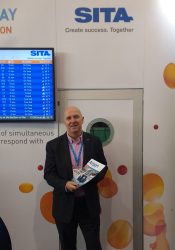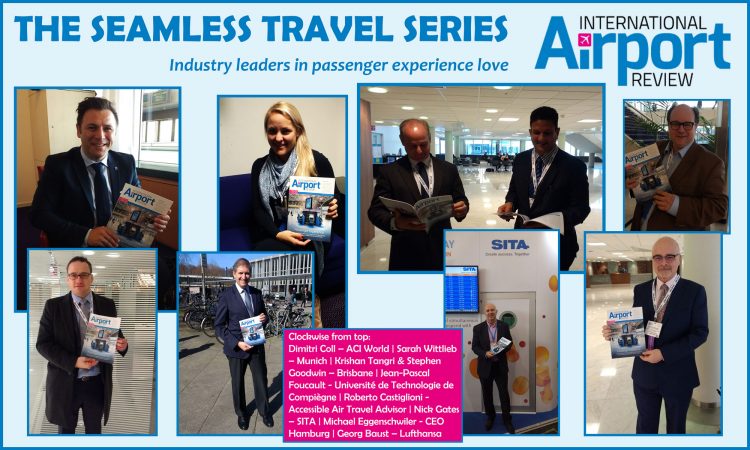SITA: Using big data to improve operational efficiency | Seamless Travel Series
- Like
- Digg
- Del
- Tumblr
- VKontakte
- Buffer
- Love This
- Odnoklassniki
- Meneame
- Blogger
- Amazon
- Yahoo Mail
- Gmail
- AOL
- Newsvine
- HackerNews
- Evernote
- MySpace
- Mail.ru
- Viadeo
- Line
- Comments
- Yummly
- SMS
- Viber
- Telegram
- Subscribe
- Skype
- Facebook Messenger
- Kakao
- LiveJournal
- Yammer
- Edgar
- Fintel
- Mix
- Instapaper
- Copy Link
Posted: 24 April 2017 | Nick Gates | SITA, Sarah Wills | Editorial Assistant | No comments yet
International Airport Review’s Roy Manuell interviews Nick Gates, SITA UK, discussing how responsible use of data has the potential to drastically improve airport operational efficiency.


Airports, as indeed could be argued of many forms of transport, frequently struggle to achieve their scheduled departure times, often seeing long, and perhaps, unforeseen delays. Nick Gates, Product Portfolio Director at SITA UK offers his insight.
Just how extensive is the issue of disruption within our industry?
What SITA has started to investigate over the last couple of years is what I call ‘irregular operations’, so that’s when disruption occurs. Disruption at airports affects airlines – disruptions in the air, bad weather, air traffic control delays – they’re all affecting the ability of an aircraft to leave on time, to achieve on-time departure. SITA is currently generating a report that looks at all the airlines in the world and gauges how successful they are in terms of their flights leaving on time. Presently, on-time departure tends to have a success rate of between 45 – 85%, and on time can mean within 15 minutes of the scheduled departure, so you could be 15 minutes late and this would still be considered as on time. What must be noted too is that this percentage of flights which leave late also therefore have a good chance of arriving late at their destination too.
At SITA we are aiming to develop services which can predict when this disruption is going to occur; because if you can predict that it’s going to occur, if you can predict why it’s going to occur, then you can take appropriate action to mitigate it, and also try to understand the effects of that disruption.
If one small flight carrying 100 people is going to be delayed then that is, of course, unfortunate but it’s not the end of the world. On the other hand, if there are major weather problems at an airport, and especially if it’s a hub airport, then potentially hundreds of flights are going to be delayed. The after effects are that potentially tens of thousands of passengers’ journeys will be disrupted, so it’s arguably more important to focus your attention and resources on this disruption.
If you can predict that it’s going to occur, if you can predict why it’s going to occur, then you can take appropriate action to mitigate it…
We have an ongoing project that’s based around using smart technology, data analytics, artificial intelligence, using all sorts of different data sources; the weather, passenger information, other transport information, twitter feeds. All of the information from all these data sources is processed in a huge data analytics tool which then calculates or predicts the chances of each flight being delayed, and it makes those predictions 48 hours in advance, 24 hours in advance, 12 hours in advance, and the closer you get to the time of scheduled departure the more accurate the predictions about the delays should become.
The first version of this technology will be available in about 3 months’ time, when we hope to make the service primarily available to airlines, first of all. Airlines naturally need to constantly concern themselves with their network of flights around the world as a whole. For example an airline such as British Airways which flies to 100 destinations, continually has aircraft in multiple locations. Disruption at one airport has consequences for other flights due to be taken by that aircraft during the same day.
Sounds very exciting; the idea of not re-action but essentially pre-action by the use of calculated predictions based on data…
Yes, and in terms of data it is finding and knowing which sources of data to use that’s the challenge. We have to ask ourselves what is important to, and has the greatest impacts on, an aircraft’s operations? The weather? What’s going on at an airport? The number of passengers on a flight? A threatened strike by ground handlers? A problem with Air Traffic Control?
In terms of data it is finding and knowing which sources of data to use that’s the challenge…
We’re beginning by using half a dozen data sources, ingesting all of the data from them, training our models, and then measuring how accurate our predictions are. As we fine tune the technology we’ll continue to search for new sources of data which are relevant. What we definitely do not want to do is ingest huge amounts of data which aren’t relevant.
How do you go about ensuring the quality of the data?
That’s something that we are looking to answer at the moment. To some extent you can start using a new source of data, test it in the model, see how it affects the predictions, and then look at the predictions and see how they compare with reality. So in some respects you have to plough through the quantity in order to determine what is the quality. By testing the different sources you can determine whether it’s a good or bad source or whether that particular source has more effect on accurately predicting time of departure.
Could you provide more information on some of the specific data sources that your technology utilises?
There’s twitter feeds, there’s NOTAMs (notices to air men) which is a service that essentially broadcasts information notices to pilots. Let’s imagine that a pilot wants to know what’s happening at Singapore Airport, and the information from NOTAMs shows that taxi way 23 is going to be closed on Wednesday night. The pilot then knows that when he gets to the airport he might be diverted a different way around the airport, and subsequently there’s going to be an effect on the taxi time. So we can use this piece of information, particularly in predicting departure times for subsequent flights, as if taxiing takes five minutes longer than usual, this flight will most likely ultimately arrive at its destination five minutes later than scheduled. It’s by pooling a combination of data from esoteric, practical and more general information sources which enables the technology to make its predictions.
NOTAMs seems, to me, to be very much a quality information source.
Yes it is, NOTAMs is very much quality, while twitter for instance is a quantity in which you need to search for or select the quality pieces of information relevant to us (the quality). No app would ever be 100% relevant, and so the skill is in detecting the relevant information from data sources which we have found to have the greatest effect on prediction success rate.
I think social media has a role to play in many aspects of aviation and especially for an airport. In Europe in particular a fear exists surrounding data being shared, how do you combat that especially when data forms such an integral part of what you’re trying to achieve?
We’re not going to be consuming personal information; our technology won’t be accessing an individual’s name, address, flight details for instance. Our technology only uses information from individuals that they’d have made available in the public domain themselves.
How do you communicate the transparency of what you’re doing?
Admittedly, what we are doing is somewhat invisible to your average passenger. However, we take the issues of data integrity and privacy very seriously, to make sure that we only publish and share data with the right people. We have an initiative within our organisation dedicated to this because there are many, ever evolving, EU regulations regarding data privacy, and we are always ensuring that we fully comply with them.
How we convey this is ultimately difficult because we are not visibly evident to passengers when they travel. However, I would say that as our ‘consumers’ are the airline or airport, perhaps it is their responsibility to gain passenger trust regarding data rather than us directly.
So other than big data, what are you most excited about technologically?
For me, in my day-to-day job, it would have to be the building of modern airport operational control centres. A good example is the CERN Control Room in Geneva, for the Large Hadron Collider (LHC); a big monitor room, full of large monitors and big screens, from where the scientists utilise their technology to monitor the state of The Collider. An airport operational control centre is that but dedicated to an airport. Often a single airport will have its own control centre, although in some countries you may have one for a network of airports, especially if they are owned and operated by the same company. Each centre works around the concept of trying to get different people in different functions working more closely with each other. The idea is to put everybody in an environment where they are close together, co-locate people so that they operate more efficiently with the aid of the latest technologies and large displays all around them. Before such centres, different sectors worked very independently from one another and only shared information remotely.
How widely is this implemented?
It varies between different airports. London Heathrow or Gatwick or Amsterdam, essentially the larger airports, tend to have operational control centres, and it’s slowly rippling down to the smaller airports. However, due to the rapid pace of ever evolving technology, some of the older operational control centres now don’t have the same capabilities as we see being used in newer centres. The result of which is that they aren’t able to use information as intelligently and share this information from different sources via the screens, enabling the better working collaborations that lead to better decisions.
So imagine we’re having this conversation in a year’s time, what will have changed?
I would hope that in a year’s time we will have the evidence to show that we can give incredibly accurate predictions about disruption. That’s what I really hope for, because what we really want to do is make this a service available to other people, not just airlines. We would only be able to do that if we can prove to the whole industry that our predictions are accurate. I want airlines and airports to be so confident in our predictions that they will base their decisions on them.
International Airport Review would like to thank SITA‘s Nick Gates for his insight and invites you to have a look at The Seamless Travel Series so far…


Elevating experience at Hamburg – Hamburg CEO Michael Eggenschwiler
Small changes, big differences for PRMs – Roberto Castiglioni, Accessible Air Travel Advisor
















